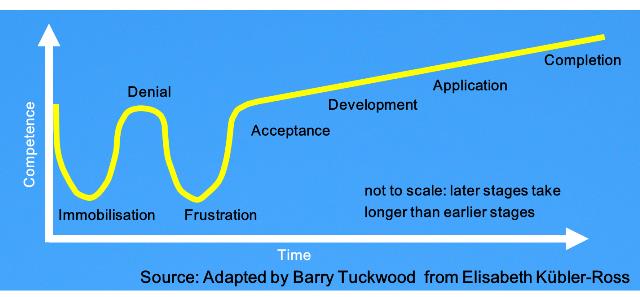Change Management: People need time
People take time to accept and implement change. Many of us are familiar with the princliples behind the figure developed by Elisabeth Kübler-Ross and adapted for change management as shown here.

The sequence from first hearing about the changing situation and what is required is familiar:immobilisation while being unable to accept that the existing ways need to change; then denying a need for change, then being frustrated with the old way when a new way is available; and then acceptance. This part of the process can be long and difficult. Actual development, application and completion is likely to take longer than the earlier phases, but from the point of acceptance the way ahead should be clearer and more positive.
When contemplating and implementing change we need to be aware that people respond at different rates and might be at entirely different stages in this process. While those behind the implementation are well aware of the purpose and the benefits, others will find it all very new and challenging, the future uncertain. Even for people who are confident of their future, the changes that affect other people might also affect them. What might have seemed certain will become less certain if newly-involved team members become worried about their future. Here are some key points:
- Everyone faced with a change will respond differently
- People will have different business and personal aspects to consider – job security, job location, roles and responsibility, social links – which might all be affected by changes
- People will be at different stages in the process – denial and frustration for some, acceptance and development for others
- There will be variation from department to department, for example executive management and strategy staff might have learned more about hte change and be further on into acceptance
- Tose further on in the process will be frustrated at the lack of progress by other colleagues
- When there is a major change, there will be questions about what the other options are, and a communication plan is needed for everyone, to show want is happening, why it is happening, what the other options were, and why the selected option was chosen
- This communication plan can consider intenal company aspects as well as customers, suppliers, regulators and other stakeholders. Everyone's needs are different but the communication strategy has to ensure that the messages are consistent
How is change working for you? Please contact me for a discussion.
